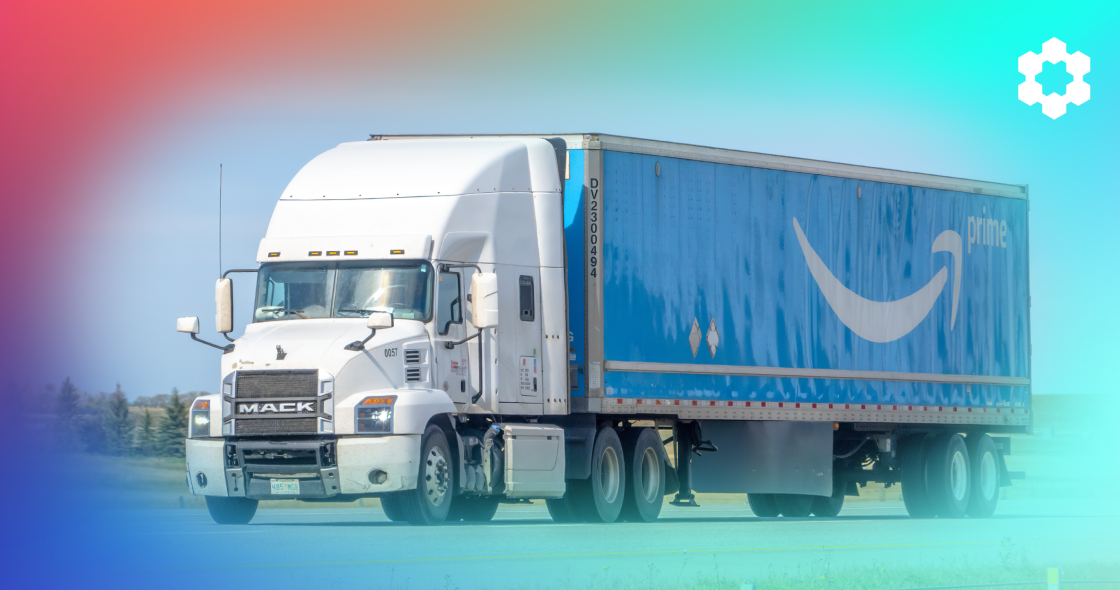Top Amazon Seller News You Need to Know This Week
This week’s news roundup highlights major developments that could reshape logistics, ecommerce competition, and seller performance tracking.
- Amazon Expands LTL Freight Operations: Amazon is planning to launch a new less-than-truckload (LTL) freight service by 2026, aiming to disrupt traditional freight logistics yet again. Analysts see potential risks for the industry but note challenges like Amazon’s reluctance to hire company drivers.
- Amazon vs TikTok Shop: Amazon is bringing its budget shopping platform, Haul, to Europe later this year, competing directly with Temu and Shein. At the same time, TikTok Shop is expanding into Italy, Germany, and France, with Japan and Brazil also in the pipeline.
- New Tools to Track and Prevent Product Return Badges: Updates to Amazon’s Voice of the Customer dashboard now allow sellers to monitor ASINs with frequent return badges. The tool provides return rate insights, risk warnings, and suggested benchmarks to help sellers improve product quality and reduce returns.
Continue reading to learn how these Amazon seller updates could impact your business.
Amazon Plans to Conquer LTL Freight
Amazon is reportedly expanding its logistics services by venturing into the Less-Than-Truckload (LTL) freight market, aiming to disrupt traditional industry dynamics. This move has potential implications for both sellers and established logistics providers.
Amazon’s LTL Expansion Plans
- Strategic Development: According to Trucking Dive, Amazon is looking to form a Dispatch & Disruption team within its Amazon Freight division to develop a “disruptive transportation product,” showing its intent to become a formidable player in the LTL sector.
- Global Rollout: In Europe, the company first launched its LTL services in the UK and expanded to Germany in 2023, reflecting its mission to become the most trusted freight provider for shippers worldwide.
Potential Impact on Sellers
- Enhanced Shipping Options: Sellers could benefit from more competitive shipping rates and improved service levels as Amazon integrates LTL services into its logistics offerings.
- Streamlined Operations: Utilizing Amazon’s LTL services may lead to more efficient inventory management and faster delivery times, enhancing customer satisfaction.
Challenges and Industry Response
- Skepticism Among Competitors: Despite Amazon’s ambitions, J.P. Morgan analysts question its ability to establish itself as a standalone national LTL carrier, citing infrastructure challenges such as terminal operations—freight management hubs—and freight network density—shipment volume and efficiency.
- Labor Considerations: The potential for labor resistance exists, as unions like the Teamsters may seek to unionize Amazon’s trucking workforce, complicating its expansion plans.
To adapt, consider:
- Evaluating Shipping Strategies: Assess the feasibility of integrating Amazon LTL into your logistics plan to potentially reduce costs and improve delivery times.
- Diversifying Logistics Partners: Maintain relationships with multiple carriers to ensure flexibility and mitigate risks associated with relying on a single provider.
Amazon vs TikTok Shop in the Global Marketplace Arena
In a strategic move to counter competitors like Temu and Shein, Amazon is set to expand its discount storefront, Haul, beyond the US, targeting Europe and Mexico later this year. Launched in November, Haul offers products priced at $20 or less, accessible exclusively through Amazon’s mobile app.
Simultaneously, TikTok Shop is broadening its reach by entering Italy, Germany, France, Japan, and Brazil. The platform integrates shopping features directly into TikTok’s interface, allowing users to purchase items showcased in videos and live streams.
What This Means for Sellers
Sellers face a transformed retail landscape as Amazon Haul and TikTok Shop push into new territories. While the potential for increased sales and brand visibility is significant, sellers must also navigate rising competition, logistical complexities, and changing consumer expectations.
Enhanced Market Access
Expanding into new markets allows sellers to reach a wider customer base, increasing potential revenue streams. Amazon’s Haul and TikTok Shop’s entry into Europe, Japan, and Latin America opens the doors for merchants to access consumers who may not have previously engaged with their products.
However, sellers must adapt to varying consumer preferences across different regions. For instance, while minimalist styles may dominate the US fashion market, European buyers may favor bold prints or vintage aesthetics, requiring brands to adjust their product selection accordingly.
Discover profitable products faster with ScanUnlimited. Our wholesale sourcing platform scans thousands of supplier lists instantly, identifying high-margin opportunities with proven demand. Find your next bestseller now.
Increased Competition
With more sellers vying for attention on these expanding platforms, businesses must differentiate themselves to stand out. Haul and TikTok Shop are both price-driven platforms, meaning sellers must find a balance between competitive pricing and profitability while offering unique products.
However, small sellers may struggle to keep up with the aggressive discounting strategies of larger retailers or manufacturers who can afford to sell at razor-thin margins to capture market share.
Logistical Considerations
Expanding to global markets comes with complex supply chain challenges, including shipping costs, fulfillment speed, and compliance with regional regulations.
For example, platforms like Fulfilled by TikTok (FBT) in Germany aim to simplify logistics by handling storage, packaging, and delivery on behalf of sellers. Similar to Amazon FBA (Fulfilled by Amazon), this service allows businesses to offload logistics to the platform, ensuring faster shipping times and better customer service standards.
But not all sellers can afford to use fulfillment services, particularly those just entering a new market. For instance, a handmade jewelry seller from Mexico looking to enter TikTok Shop Europe may face high shipping costs, making it difficult to compete on both price and speed against local European vendors.
Amazon’s New Return Badge System Sparks Seller Frustration
Amazon has introduced a new set of return tracking tools within its Voice of the Customer (VOC) dashboard, aimed at helping sellers monitor and reduce product return rates. Although these updates provide more visibility into return data, many sellers feel they fail to address the root issue of return fraud and abuse—and may even punish legitimate businesses.
What’s New?
Amazon’s latest update to the VOC dashboard includes:
- A list of ASINs that already have the “Frequently Returned” badge on their detail pages.
- A warning system for ASINs at risk of receiving the badge.
- Return rate data spanning 3 months and 12 months for trend analysis.
- Suggested return rate benchmarks to help sellers prevent or remove the badge.
Sellers can access these insights by navigating to Performance > Voice of the Customer in Seller Central and clicking on the new “Return badge displayed” column.
How It’s Supposed to Help Sellers
In theory, this system allows sellers to:
- Identify problematic products early and make improvements.
- Track return rates over time and compare them to Amazon’s suggested benchmarks.
- Take proactive steps to reduce returns and prevent return-related penalties.
However, while the additional data is appreciated, many sellers argue that this update misses the real issue—return fraud and competitor abuse—and lacks essential tools for defending against unfair penalties.
Seller Frustrations: More Punishment, No Protection
1. No Way to Challenge Return Claims
Many sellers feel helpless because Amazon does not allow them to dispute return reasons—even when they know the claims are false or fraudulent.
One seller wrote, “The voice of the customer dashboard is completely ridiculous. A seller cannot respond or defend these ‘claims,’ which are usually wrong or incorrect.”
This lack of transparency means sellers are penalized for returns that may have nothing to do with product quality, such as:
- Customers buying multiple sizes and returning what doesn’t fit.
- Competitors or resellers returning swapped or used goods.
- Buyers falsely claiming an item is “defective” to avoid return shipping fees.
2. No Search or Filter Functionality
A major complaint is the difficulty in finding affected ASINs, as sellers must manually scroll through hundreds of pages. One seller commented, “Why can’t we sort/search by this new field? Are we supposed to scan thru 100’s of pages (with MANY duplicates) to see which ones have the badge?”
This lack of efficiency makes it harder for sellers to take action, contradicting the intended purpose of the tool.
3. Encouraging More Returns?
Some sellers worry that the Frequently Returned badge will do more harm than good, by alerting buyers that returning items is common and easy.
Rather than discouraging returns, this system could normalize the practice and make it easier for scammers to target vulnerable listings.
4. No Protection Against Return Fraud
Sellers have been pleading for Amazon to crack down on bad actors who manipulate the return system, but this update doesn’t address those concerns.
For one seller, “This badge is simply a way for scammers to find the products that are easiest to steal from sellers. Amazon will not stop this abuse but will further punish sellers for it because return rates are too high, even when they aren’t valid returns.”
Some sellers report competitor-driven returns, where rival businesses purchase items, return them in damaged or swapped condition, and harm a seller’s metrics.
Final Thoughts
Amazon’s new return tracking features offer some valuable insights, but they fail to address the root causes of return abuse. Instead of empowering sellers, many believe this update simply provides more ways for Amazon to penalize them while doing little to stop fraudulent buyers and bad actors.
Unless Amazon introduces safeguards—such as returns abuse tracking and dispute options—sellers may continue to feel that the deck is stacked against them in a system that prioritizes customer convenience over seller protection.
Discover and reclaim the funds Amazon owes you Seller Investigators. Our FBA reimbursements solution recovers hidden profits by identifying inventory losses, shipping errors, and refund discrepancies. Start your free audit now and see what you’re missing.
Other Amazon Seller Updates This Week
1. Get Your FBA Donations Certificate for Tax Season
Amazon’s FBA Donations program allows sellers to donate excess inventory, including returns and overstock, to US nonprofits instead of disposing of them. Sellers can now access a donation certificate in Seller Central, providing necessary documentation for potential tax deductions.
2. Recover Up to 80% of Value from Returns with FBA Grade and Resell
Amazon’s FBA Grade and Resell program helps sellers automatically grade and relist returned products as used, reducing losses from returns. Available in multiple European markets, this program allows sellers to set their own prices, with no additional program fees for now.
3. New UK EPR Pay on Behalf Service Fee Starts April 1, 2025
Amazon will begin charging a £20 per-category service fee for Extended Producer Responsibility (EPR) compliance on packaged goods sold in the UK. While Amazon will continue covering eco-contribution fees, this new charge helps offset administrative costs, and non-UK professional sellers will be automatically enrolled.
4. New Trump Tariffs on Mexico, Canada, and China Take Effect
The US has imposed steep tariffs potentially raising costs for food, electronics, and auto parts, which could squeeze margins and drive up prices. In response, Canada, Mexico, and China are planning retaliatory tariffs, potentially disrupting supply chains and increasing costs further for Amazon sellers.
5. Amazon Ads Launches Sponsored TV in India
Amazon has introduced self-service streaming TV ads in India, enabling brands selling on Amazon.in to reach a broader audience through connected TV platforms. The ads leverage machine learning for optimization, require no minimum spend, and offer a cost-effective way for sellers to boost brand visibility.
Expand your reach with DSP Prime. Our expert-managed advertising solution leverages Amazon’s first-party data to connect your brand with high-intent audiences across websites, apps, and streaming platforms. Get your customized growth plan now and launch in just 10 days.
What These Updates Mean for Sellers
With Amazon’s expanding logistics ambitions, the rise of TikTok Shop as a competitor, and new return tracking tools, it would be best to take proactive steps to stay competitive and protect your businesses. Here are some strategies to navigate these updates effectively:
- Optimize Your Logistics Strategy: Assess whether Amazon’s upcoming LTL services could reduce costs or improve efficiency, but maintain relationships with alternative logistics partners to avoid dependency. And as Amazon Haul and TikTok Shop expand globally, explore diverse fulfillment options such as Amazon FBA, third-party logistics (3PLs), and TikTok’s FBT.
- Compete in the New Marketplace Landscape: Research regional consumer preferences and trends to tailor your product offerings for platforms like Haul and TikTok Shop. Balance competitive pricing with profitability, as these marketplaces attract budget-conscious shoppers.
- Leverage Social Commerce: TikTok Shop’s strength lies in content-driven sales—consider influencer collaborations or creating short-form product videos to boost visibility.
- Minimize the Impact of Return Badges: Regularly monitor ASIN return rates in Amazon’s Voice of the Customer dashboard and address issues proactively. More importantly, track and report return fraud by documenting repeat offenders, submitting SAFE-T claims, and advocating for stronger fraud detection measures.
- Enhance Product Clarity: Improve listings with accurate sizing charts, clear images, and detailed specifications, and use infographics or videos to educate customers on proper usage, assembly, or sizing to reduce returns.
For nearly four years, we’ve kept sellers informed with our Amazon Sellers Newsletter, publishing over 200 issues packed with policy changes, announcements, and community events. Subscribe or share with your team to get these insights delivered weekly.




